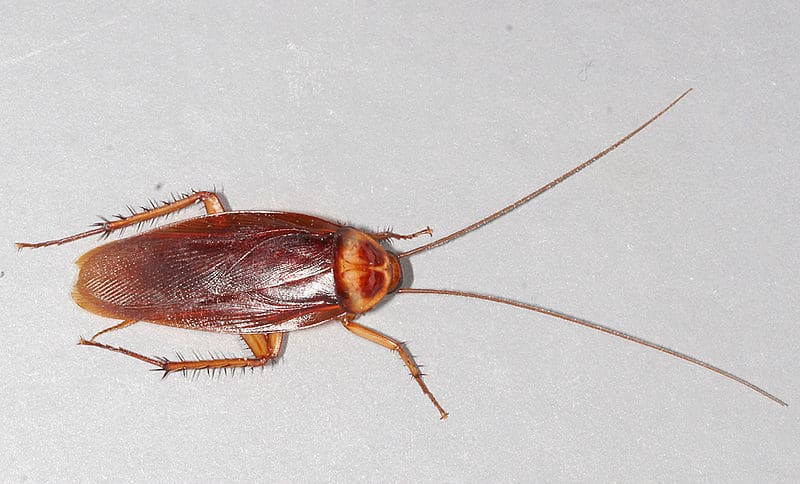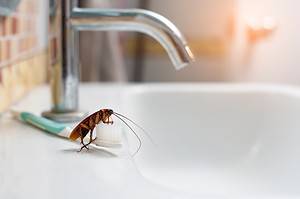Cockroaches are known the world over for their pungent aroma and ability to hunt out and eat just about any type of garbage. They’re members of the order Blattodea, an order that also includes termites. Cockroaches are medium size, dark colored insects with hard, shiny exoskeletons. They’re often mistaken for beetles, or water bugs; in some places they’re also called palmetto bugs. But, are cockroaches the same thing as roaches?
Here, we’ll answer that question, and learn more about just what a cockroach is, and what other insects they’re often mistaken for. We’ll go in depth on where cockroaches get their name, and take a closer look at a few of the most common species of cockroach. Finally, we’ll examine the signs of a cockroach infestation, and what you can do to get rid of these pestilential bugs.
What Is a Cockroach?
Cockroaches begin life as nymphs that hatch from eggs. These eggs are sometimes encased in egg cases that resemble dried kidney beans, and sometimes they’re kept safe inside the mother. Regardless of the method, when the baby cockroaches hatch, they’re known as nymphs. The nymphs grow bigger, shedding their exoskeleton several times as they do, until they become adults.
Adult cockroaches are usually dark brown to reddish brown, and between ¼ inch and 4 inches long. They have six legs that they use for climbing, digging, and fitting into tiny cracks. Their antennae are the length of the rest of their body; they use them to find food, sense danger, and communicate with other cockroaches.
Cockroach, Or Something Else?

Cockroaches have very long antennae and narrow bodies
©Gary Alpert at the English language Wikipedia / Creative Commons – Original
With over 4,500 species worldwide, it’s no wonder cockroaches are often confused with other bugs. They’re very similar in appearance to beetles—both have hard, shiny, dark bodies, and are usually found on the ground. However; cockroaches have much longer antennae, and their bodies tend to be narrower, with smaller abdomens than beetles.
Water bugs are also often mistaken for cockroaches. But, water bugs have very distinct pincer-like appendages on their heads, and no antennae. Additionally, water bugs have very large eyes that can be seen from above. Cockroach’s heads are actually invisible from above; we see only a hard shield called a pronotum, which protects the cockroach’s head.
The Difference Between Cockroach and Roach
Now that we know what a cockroach is, and what it isn’t, let’s take a look at the different names we give to these ubiquitous household invaders. The difference between cockroaches and roaches is: nothing. ‘Cockroach’ and ‘roach’ are two names for the same thing, and though either may refer to any one of the over 4,000 species of roach, they’re not distinct.
‘Roach’ is the shortened version of the word ‘cockroach’. It’s used regionally, with some parts of the world calling these insects almost entirely by one name or the other. It’s also typical parlance for scientists and professional exterminators familiar with the bugs. So; a roach is a cockroach, and a cockroach is a roach.
Behind the Name
The name ‘cockroach’ is actually the anglicized version of a Spanish word. In Spanish, roaches are known as ‘cucaracha’, the English pronunciation being ‘cockroach’. Additionally, cockroaches belong to the Blattodea order of insects. In Latin, Blatta means ‘insect that shuns the light’. Given their propensity for scattering when the lights go on, it’s obvious why these nocturnal creatures were given this name.
A Few of The Most Common Types of Roach
Only about 1%, or around 30 total, species of cockroach have anything to do with humans; the rest live out their lives in the wild. These roaches are common pests, and tend to congregate around garbage, clutter, and waste. They also love sewage systems and plumbing, and some even prefer the warmth of electrical devices. They’re all roaches—let’s take a look at a few of the most common urban cockroach species.
American Cockroach
These roaches prefer restaurants, and other places where food is prepared. They’re almost always found in basements or on the first floor—adults can only manage short glides, and not true flight. They grow up to two inches long and can live up to three years. In those three years, female American cockroaches can produce up to 16 egg cases, each with 14-16 eggs.
German Cockroach

Cockroaches and roaches are the same thing, regardless of the species
©iStock.com/Dzurag
The most common species of indoor roach, the German cockroach grows to only ½ inch long. They’re light brown with two dark brown stripes that run from tail to snout. They’re especially common in multi-unit housing units and homes near the ends of sewer lines. They only live about a year, but in that year they can produce up to eight egg cases—each with 30-50 eggs inside.
Brown-banded Cockroach
These roaches thrive in the heat; they prefer 80 degrees and above. Brown-banded cockroaches can often be found on walls, behind paintings and pictures, as well as near warm electrical appliances. They only grow to ½ inch long, and live for about a year. Their egg cases look like tiny coffee beans; the eggs inside take up to 70 days to mature.
Cockroach Infestations
Whether you call it a roach or a cockroach, an infestation is bad news. Signs of cockroach infestation include; the presence of roaches, stains and bad smells, roach droppings, shed exoskeletons, and egg cases. If you suspect you may have a cockroach infestation, you may want to call a professional pest exterminator. If you would rather take matters into your own hands, you can also place traps and use insecticides to attempt to take care of the problem. Be sure to consult an expert for advice before trying any at home methods.
The photo featured at the top of this post is © PitukTV/Shutterstock.com
Thank you for reading! Have some feedback for us? Contact the AZ Animals editorial team.







